
Mountbatten-Windsor is the personal surname used by some of the male-line descendants of Queen Elizabeth II and Prince Philip, Duke of Edinburgh. Under a declaration made in Privy Council in 1960, the name Mountbatten-Windsor applies to male-line descendants of Queen Elizabeth II without royal styles and titles. Individuals with royal styles do not usually use a surname, but some descendants of the Queen with royal styles have used Mountbatten-Windsor when a surname was required.

Duke of Kent is a title that has been created several times in the peerages of Great Britain and the United Kingdom, most recently as a royal dukedom for the fourth son of King George V. Since 1942, the title has been held by Prince Edward, Queen Elizabeth II's cousin.
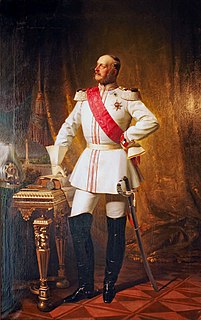
George V was the last King of Hanover, the only child and successor of King Ernest Augustus. George V's reign was ended by the Austro-Prussian War, after which Prussia annexed Hanover.

Prince William Henry, Duke of Gloucester and Edinburgh,, was a grandson of King George II and a younger brother of George III of the United Kingdom.

The use of the title of Princess of the United Kingdom of Great Britain and Northern Ireland is entirely at the will of the sovereign as expressed in letters patent. Individuals holding the title of princess are styled "Her Royal Highness" (HRH). On 18 April 1917, the newest granddaughter of Wilhelm II, German Emperor was styled a British princess from birth, even though Germany and Britain were fighting in WWI. Before the First World War, British Princesses also held additional German titles, such as Princesses of Hanover by virtue of being male line descendants of George III; or Princesses of Saxe-Coburg and Gotha, Duchess of Saxony, by virtue of being male line descendants of Prince Albert of Saxe-Coburg and Gotha. George V issued Letters Patent on 30 November 1917, to restrict the automatic assignment of the title "Princess" and the use of the style "Royal Highness" to the following persons:
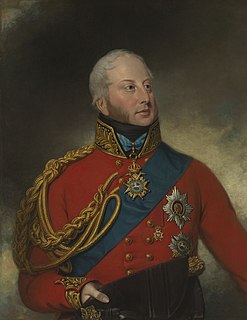
Prince William Frederick, Duke of Gloucester and Edinburgh, was a great-grandson of King George II of Great Britain and the nephew and son-in-law of King George III. He was the grandson of both Frederick, Prince of Wales, and Edward Walpole. Prince William married Princess Mary, the fourth daughter of George III.

Earl or Mormaer of Strathearn is a title of Scottish nobility, referring to the region of Strathearn in southern Perthshire. Of unknown origin, the mormaers are attested for the first time in a document perhaps dating to 1115. The first known mormaer, Malise I, is mentioned by Ailred of Rievaulx as leading native Scots in the company of King David at the Battle of the Standard, 1138. The last ruler of the Strathearn line was Malise, also Earl of Caithness and Orkney, who had his earldom forfeited by King Edward Balliol. In 1344 it was regranted by King David to Maurice de Moravia, a royal favourite who had a vague claim to the earldom as Malise's nephew and also stepfather.
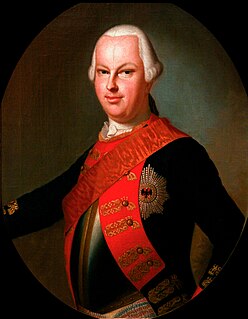
Louis IX of Hesse-Darmstadt was the reigning Landgrave of Hesse-Darmstadt from 1768 to 1790.
A Royal Fellow of the Royal Society is a member of the British royal family who has been elected a Fellow of the Royal Society. The council of the Royal Society recommends members of the Royal Family to be elected and then the existing Fellows vote by a secret ballot whether to accept them. The ballots have only a box to tick supporting the measure; those opposing have to write "no" or otherwise mark or spoil the paper. As of 2022 the Patron was Queen Elizabeth II, and Royal Fellows were:

The Royal Burial Ground is a cemetery used by the British royal family. Consecrated on 23 October 1928 by the Bishop of Oxford, it is adjacent to the Royal Mausoleum, which was built in 1862 to house the tomb of Queen Victoria and Prince Albert. The burial ground lies on the Frogmore estate within the Home Park at Windsor, in the English county of Berkshire.
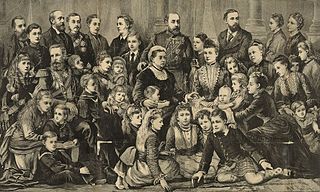
Queen Victoria, the British monarch from 1837 to 1901, and Prince Albert had 9 children, 42 grandchildren, and 87 great-grandchildren.

St George's Chapel at Windsor Castle in England is a castle chapel built in the late-medieval Perpendicular Gothic style. It is both a Royal Peculiar and the Chapel of the Order of the Garter. St George's Chapel was founded in the 14th century by King Edward III and extensively enlarged in the late 15th century. It is located in the Lower Ward of the castle. The castle has belonged to the monarchy for almost 1,000 years and was a principal residence of Elizabeth II before her death. The chapel has been the scene of many royal services, weddings and burials – in the 19th century, St George's Chapel and the nearby Frogmore Gardens superseded Westminster Abbey as the chosen burial place for the British royal family. The running of the chapel is the responsibility of the dean and Canons of Windsor who make up the College of Saint George. They are assisted by a clerk, verger and other staff. The Society of the Friends of St George's and Descendants of the Knights of the Garter, a registered charity, was established in 1931 to assist the college in maintaining the chapel.

On 6 July 1893, Prince George, Duke of York, and Princess Mary of Teck were married at the Chapel Royal, St. James's Palace, in London, England.

The House Order of Albert the Bear was founded in 1836 as a joint House Order by three dukes of Anhalt from separate branches of the family: Henry, Duke of Anhalt-Köthen, Leopold IV, Duke of Anhalt-Dessau, and Alexander Karl, Duke of Anhalt-Bernburg.
Since William the Conqueror claimed the English throne, succession has been determined by bequest, battle, primogeniture, and parliament.

The House Order of the Wendish Crown was an Order of the House of Mecklenburg, jointly instituted on 12 May 1864 by Grand Duke Friedrich Franz II of Mecklenburg-Schwerin and Grand Duke Friedrich Wilhelm of Mecklenburg-Strelitz.
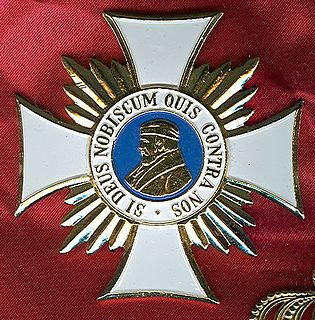
The Order of Merit of Philip the Magnanimous was an order of chivalry established by Louis II, Grand Duke of Hesse on 1 May 1840, the name day of Philip I, Landgrave of Hesse, in his honour to award extraordinary military or civil merit. It was the second-highest order of the Grand Duchy of Hesse before 1876, when it was displaced to third by the revived Order of the Golden Lion, the former paramount order of the Electorate of Hesse.

The state funeral of Victoria, Queen of the United Kingdom of Great Britain and Ireland, Empress of India, occurred on 2 February 1901, after her death on 22 January. It was one of the largest gatherings of European royalty.
This is a list of the etymology of street names in the area of Regent's Park in London ; the area has no formal boundaries, though it generally thought to be delimited by Prince Albert Road to the north, Park Village East and Hampstead Road/the Euston railway line/Eversholt Street to the east, Euston Road and Marylebone Road to the south and Park Road and Baker Street to the west.

















